How to grow watermelon: expert tips on growing this refreshing fruit
Find out how to grow watermelon and you'll soon be wondering why you've never tried it before
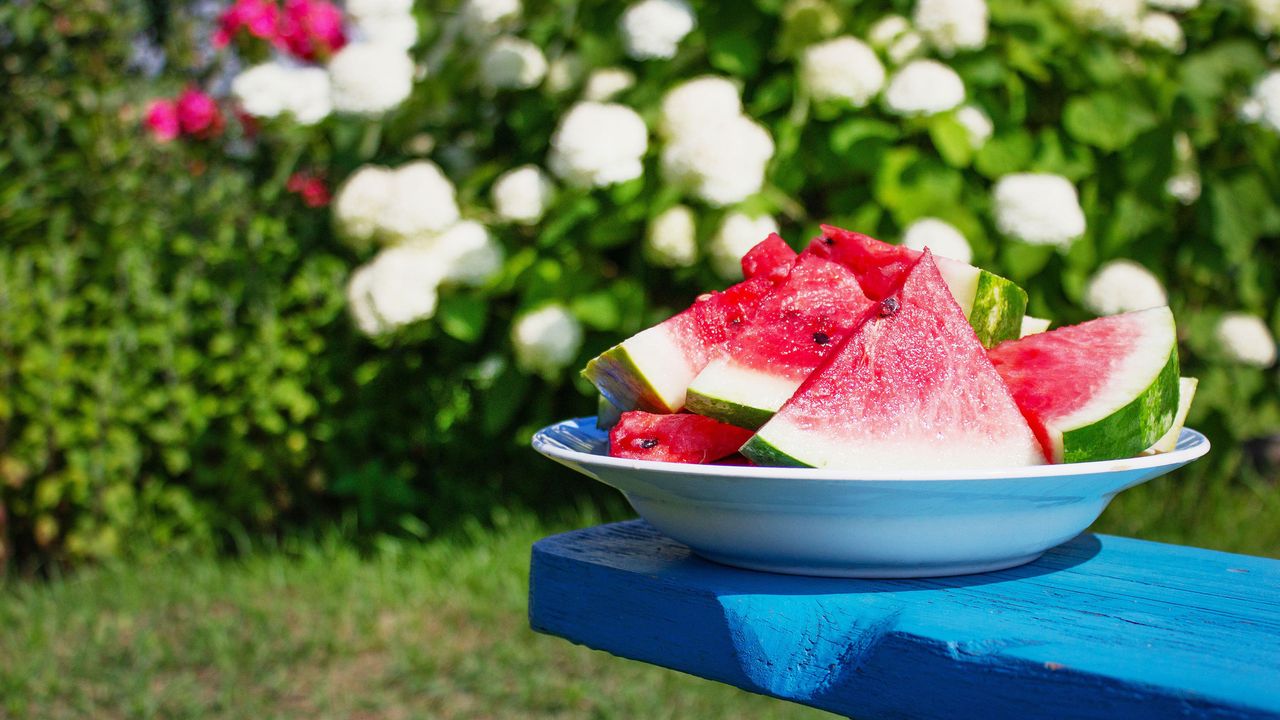

Learn how to grow watermelon and you will soon be enjoying your very own homegrown version of this most summery of fruits. A wedge of juicy watermelon is the most refreshing thing on a scorching summer day and how much more pleasing if you've actually grown it yourself.
Watermelons are not hard to grow either. The vine-like flowering plant will quickly scramble up a wigwam or sprawl over a patch of ground in your kitchen garden ideas just like a gourd. This is because as well as being a fruit, watermelon is a vegetable too. It's a member of the same family as cucumbers, pumpkins and squash.
It's bee friendly too, recommended by the RHS as an excellent source of nectar for bees and other beneficial insects. This means it's an all-round great addition to your grow your own game.
How to grow watermelon: quick tips
- It's easy to learn how to grow watermelon.
- You can start seeds off indoors then move young plants outside once the weather warms up.
- Watermelons need fertile, well-drained soil.
- They love a sunny spot.
- Plant in spring for a summer harvest.
- They like regular watering, especially when it's hot.
- Pinch out the growing tips of the plants to encourage the stems to branch and you will get more fruit.
- Grow a small variety like 'Sugar Baby' if you want one that fits in the fridge easily.
How to grow watermelon from seed
- To get the best results for how to grow watermelon, start by sowing seeds 2cm deep in 7.5cm pots of good seed compost at 70-77˚F (21-25˚C) from spring, typically April to May. There’s no need to presoak the seeds.
- Place in a propagator or cover with a polythene bag until they have germinated. After germination, maintain a minimum temperature of 60˚F (15˚C ) and keep the compost slightly moist.
- When seedlings are looking sturdy and well developed, transplant them to a new spot under glass, or into frames or cloches outdoors. They should be spaced around 1 meter apart. Find out how to transplant seedlings in our guide.
- Gradually acclimatize the new plants to outdoor conditions for a few days before planting out. Do this once there is no danger of frost.
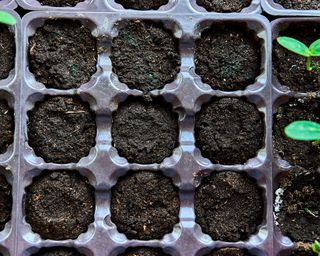
How to grow watermelon in the ground
Seeds can also be sown directly outdoors once the soil has warmed up. Watermelons need a fertile, moisture-retentive and well-drained soil.
- Three to four weeks before planting, prep the ground by removing weeds and digging in organic matter together with some general purpose fertilizer. Water well and cover in clear polythene for a week before planting as this will help to warm up the soil.
- Depending on how many you want to grow, direct sow 2 seeds every 1.5 meters in late May. Place seeds on end, blunt end pointing down into the soil, and push in, then water thoroughly.
- As soon as the seeds have germinated, thin out the seedlings keeping the strongest looking ones. Then ideally grow under cloches until the plants are well established. Add a layer of mulch to keep the area weed free. You can find out about mulching in our guide.
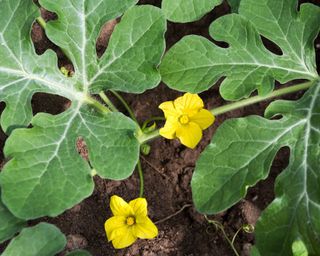
Can you grow watermelon from shop-bought fruit?
This is a great idea as saving watermelon seeds is so easy to do. Soak the seeds in a dish of water, along with a splash of eco-friendly washing up liquid to remove any sugar residue on the seeds. Rinse well, pat them dry and spread out on paper towels to dry. Leave them to dry for about a week.
Store watermelon seeds in airtight containers in a cool place. Mark an envelope with the variety of seed and the date, and tip the seeds inside. Store in the bottom of a dry container with a tightly fastening lid so no air can escape. Put in the fridge until needed, and then you can plant them in the same way you would if growing from seed.
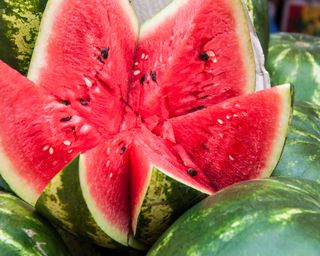
What month do you plant watermelon?
This depends where you live, but as a general rule it's usually in early spring for a delicious summer crop.
If you live in a cooler climate, sow seeds indoors first to give them a kick-start. If you live in a warmer part of the country, then you can sow seeds directly into the ground as soon as there’s no risk of frost.
How to care for watermelon
Water watermelon regularly, particularly as the flowers develop, and when it's hot. That's one of the key things to remember when it comes to how to grow watermelon.
Provide a liquid feed every 10-14 days. When fruit are the size of walnuts, feed with a high potash potassium liquid fertilizer once a week. Stop feeding and reduce watering when the fruits start to ripen and foliage dies back.
In very sunny weather, provide shade for watermelon to avoid them getting scorched.
Rest the fruits on a pillow of straw to keep them clean and prevent slug damage. If slugs are a real problem in your garden, there are plenty of natural options for how to get rid of slugs in our guide.
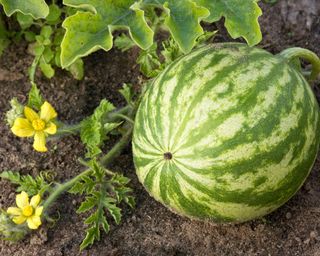
What helps boost watermelon growth?
There are a few easy things you can do if you want to become expert at how to grow watermelon. Pinch out the growing tip of the plant to encourage branching of the stems and more flower buds. It makes the plant bushier and gives you more fruit. Remove any new growths as they appear.
Make sure you ventilate your greenhouse ideas if applicable or open up poly tunnels or cold frames when the plants are in flower, as this will allow access for insects and help the plants to be pollinated to crop better.
When vines begin to ramble, give watermelon plants a dose of boron to help them produce sweeter fruit. Dissolve 1 tablespoon of household borax in 1 gallon of water, and spray foliage and the base of the plants.
When fruit are gooseberry size, select the best four on each stem and remove all other flowers, fruit and leaves.
Is it hard to grow watermelon?
Choose the right variety and it’s easy to learn how to grow watermelon. 'The watermelon variety ‘Little Darling’ doesn’t require a lot of attention,' says Simon Crawford head breeder at Burpee Europe. 'It can be staked in a pot using a cane.
'It’s also a good easy compact watermelon to try if you have a small garden. It grows up to 60cm tall so is very manageable if you don’t have a lot of outdoor space and it means you can grow three or four of them.
'It will produce fruit of a good size (often two per plant) that tastes delicious, sweet and succulent. Try growing it in a greenhouse if you live in a northern climate.'
Want more ideas for growing fruit in pots? Our guide has plenty of suggestions to get you started.
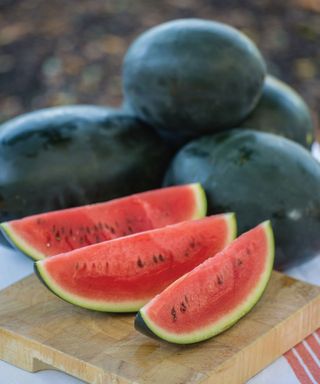
The watermelon variety 'Little Darling'
Can beginners grow watermelons?
'The one thing that causes the most surprise with people visit our nursery is when they see watermelons growing here. "You can't grow watermelons in the UK can you?" The answer is, of course, yes!’ says Stephen Shirley of the Victorian Nursery. 'They can grow to up to 60cm long and have a grey-green skin. Inside the flesh is pinky-orange and is perfectly crisp and juicy.
'Try a small variety such as ‘Seedless Big Tasty Hybrid’ that will fit in the fridge easily, or go for glory and sow watermelon seeds for a whopper like 'Million Bucks Hybrid'.'
Where is the best place to plant watermelon?
Choose the hottest part of the garden if you want to nail how to grow watermelon. They are tender plants that need lots of sun and warm conditions to thrive.
Growing like a pumpkin or squash, the plant needs to sprawl in the sunniest spot possible - ideally under protection (greenhouse, polytunnel or similar) although a really warm and sunny sheltered spot outside in your raised garden bed ideas is also fine.
If the hottest part of your garden moves around according to the time of day, consider including your watermelon plants in your container gardening ideas so that you can shift them around in response to the sun.
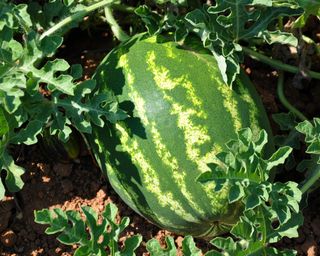
How to grow watermelon in a pot
The good news is that there are lots of tips for how to grow watermelon in pots. Smaller varieties such as 'Sugar Baby' watermelon produce fruit that can fit in the fridge. Their small size also makes them a great choice for garden planter ideas.
When learning how to grow watermelon in a planter, make sure the conditions are right. Watermelons don't like standing in water, so your pot will need good drainage.
You can grow watermelon vertically up a wigwam erected over the pot. You will need a support when the fruit starts to get heavy or they will snap off the vines before they ripen.
If you live in a cooler part of the country, grow your watermelon in a planter in the greenhouse to ensure they have a warm climate to thrive in. Not got much space in the garden? Investing in the best mini greenhouse can be a practical choice.
How to grow watermelon vertically
Watermelon will take up lots of space if you let them, with vines reaching up to a staggering 6 meters long. So plant them where there is plenty of open ground so they can spread out.
Watermelon plants can also be trained upwards on strings, wires or through a wigwam. If you're learning how to grow watermelon this way, pinch out the growing points when plenty of leaves have formed to encourage lateral shoots to develop.
As the fruit starts to get heavier you will need some climbing plant support ideas for them. Try creating a fabric cradle or string hammock that you tie to the wigwam. It will need to let light and air through so that the fruit can continue to ripen.
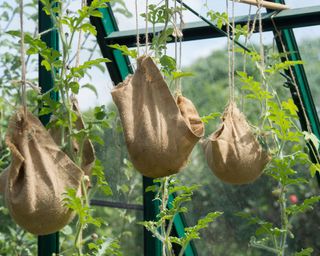
You may need to consider ways of supporting the weight of watermelons
How long does it take to grow a watermelon?
You can sow the watermelon seeds and pick the ripe fruit in the same year. Watermelon need a long growing season (at least 80 days) and warm ground for seeds to germinate and grow.
Select short-season varieties such as ‘Million Bucks Hybrid’ or ‘Orange Sunshine Hybrid’ if your growing season is less than 90 days.
To get a jumpstart in cooler climates, cover the planting area with black plastic to warm up the soil and start seeds indoors two or three weeks before they are to be planted out in the garden. Use a heat mat if necessary.
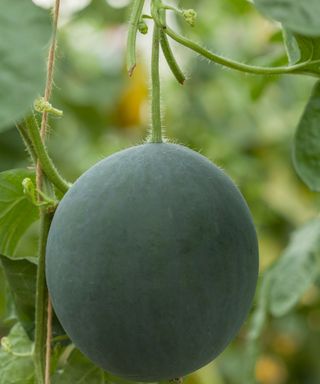
The 'Little Darling' variety of watermelon
How do you tell when watermelon is ripe for picking?
There's no definitive way of knowing when a watermelon is perfectly ready for picking. They begin to ripen from mid-summer onwards. You can probably start to harvest the fruits when you smell a strong melon fragrance.
Another indication of ripeness is the color of the bottom spot where the melon sits on the ground. As the watermelon matures, the base turns yellow. Watermelon also start to take on a dull sheen when fully ripe.
Another option is to watch the tendril closest to the stem. When it turns brown and dries up, this generally indicates that the watermelon is ripe.
Forget slapping or tapping watermelon to see if it sounds hollow as this isn't always accurate.
Another top tip for how to grow watermelon is that after you've picked it, it's best to chill it before serving. A cut melon, if covered with plastic wrap or aluminium foil, will keep for several days in the fridge. They're ideal for adding to summer salads to serve alongside the best BBQ recipes.
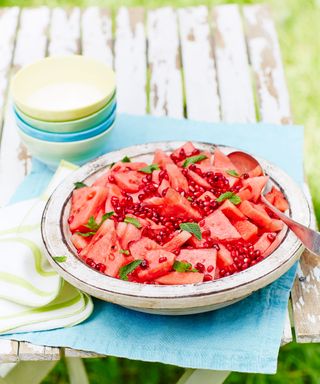
Watermelon is a lovely addition to summer salads
Where to buy watermelon seeds
If you'd like to have a go at growing watermelons here are our suggestions for the best places to buy seeds. There's a huge range available both online and at the garden center, so plenty to choose from. Use our quick links below for an easy way to fill your cart without the hassle.
Where to buy watermelon seeds in the UK:
- Shop watermelon seeds at Amazon
- Shop watermelon seeds at Burpee
- Shop watermelon seeds at Dobies
- Shop watermelon seeds at DT Brown
- Shop watermelon seeds at Marshalls
- Shop watermelon seeds at Mr Fothergill's
- Shop watermelon seeds at Thompson & Morgan
Where to buy watermelon seeds in the US:
- Shop watermelon seeds at Amazon
- Shop watermelon seeds at Burpee
- Shop watermelon seeds at Home Depot
- Shop watermelon seeds at Walmart
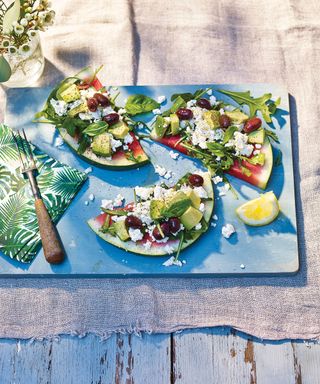

Lifestyle journalist Sarah Wilson has been writing about gardens since 2015. She's written for Gardeningetc.com, Livingetc, Homes & Gardens, Easy Gardens and Modern Gardens magazines. Having studied introductory garden and landscape design, she is currently putting the skills learned to good use in her own space where the dream is establishing a cutting garden.
